Introduction
In today’s fast-paced world, the demand for visulisation in service design that cater to holistic needs is on the rise. This shift is driven by the growing awareness of the importance of integrating various aspects of life into service design, ensuring that every touchpoint contributes to a cohesive and meaningful experience. One powerful tool in achieving this integration is visualization. But how exactly does visualization enhance holistic service design? Let’s delve into this intriguing topic.
Understanding Holistic Service Design
What is Holistic Service Design?
Holistic service design goes beyond traditional service models by considering the entire experience from multiple perspectives—emotional, functional, and sensory. It aims to create a seamless and interconnected experience that addresses the needs and aspirations of the user in a comprehensive manner.
The Importance of Integrating Multiple Touchpoints
By integrating various touchpoints, holistic service design ensures that users experience a consistent and satisfying service journey. This approach not only improves user satisfaction but also builds brand loyalty and trust.
The Power of Visualization in Service Design
Defining Visualization in Design
Visualization in service design refers to the use of graphical representations to understand, analyze, and communicate service processes and experiences. It helps stakeholders to grasp complex concepts and relationships through visual means.
Types of Visualization Tools
Journey Maps: Illustrate the user’s entire journey through a service, highlighting key touchpoints and emotions.
Service Blueprints: Detailed diagrams that outline the behind-the-scenes processes and interactions involved in delivering a service.
Personas: Fictional characters representing different user types, used to visualize their needs and behaviors.
How Visualization Enhances Holistic Service Design
Clarifying Complex Processes
Visualization simplifies complex service processes, making them more understandable for designers, stakeholders, and users. It helps in identifying pain points and areas for improvement by providing a clear, visual representation of the service journey.
Improving Communication and Collaboration
Effective visualization fosters better communication among team members and stakeholders. It provides a common language for discussing and refining service concepts, ensuring that everyone is aligned with the service vision.
Enhancing User Experience
By mapping out user journeys and touchpoints, visualization helps designers to identify opportunities for enhancing the overall user experience. It enables the creation of services that are more intuitive, engaging, and responsive to user needs.
Implementing Visualization in Holistic Service Design
Steps to Integrate Visualization
Identify Key Touchpoints: Determine the critical points of interaction in the service journey.
Choose Appropriate Tools: Select visualization tools that best represent the service processes and user experiences.
Create and Analyze Visuals: Develop visual representations and analyze them to uncover insights and areas for improvement.
Iterate and Refine: Use feedback from stakeholders and users to refine the visualizations and the service design.
Best Practices for Effective Visualization
Keep it Simple: Ensure that visuals are clear and easy to understand.
Use Real Data: Base visualizations on actual user data to ensure accuracy.
Involve Stakeholders: Engage stakeholders in the visualization process to gather diverse perspectives.
Case Studies: Visualization in Action
Case Study 1: Healthcare Service Design
A healthcare provider used journey mapping to redesign their patient experience. By visualizing the patient journey, they identified critical pain points and streamlined processes, resulting in improved patient satisfaction and operational efficiency.
Case Study 2: Retail Service Experience
A retail company utilized service blueprints to enhance their in-store experience. The visualizations revealed gaps in service delivery, leading to changes that boosted customer engagement and sales.
Challenges and Solution
Common Challenges
Complexity of Services: Complex services can be difficult to represent visually.
Stakeholder Alignment: Ensuring all stakeholders interpret visualizations consistently can be challenging.
Solutions
Simplify Representations: Focus on key elements and avoid overcomplicating visuals.
Regular Feedback: Continuously gather feedback from stakeholders to align interpretations.
Future Trends in Visualization for Service Design
Emerging Technologies
Augmented Reality (AR): Enhances visualization by overlaying digital information onto the real world.
Interactive Dashboards: Allow users to interact with data and visualizations dynamically.
Expanding Applications
Visualization will increasingly be used in various sectors, including education, finance, and public services, to enhance service design and delivery.
Conclusion
visulisation in service design plays a pivotal role in holistic service design by making complex service processes more understandable, improving communication, and enhancing user experience. By leveraging visualization tools and techniques, designers can create more integrated and effective service experiences that meet the diverse needs of users. As the field of service design continues to evolve, embracing visualization will be key to staying ahead and delivering exceptional service experiences.
FAQs
Q: What are the key benefits of using visualization in service design?
Ans: visulisation in service design helps clarify complex processes, improves communication, and enhances user experience by providing a clear representation of service interactions and touchpoints.
Q: How can journey mapping benefit service design?
Ans: Journey mapping visualizes the entire user journey, highlighting pain points and opportunities for improvement, leading to a more seamless and engaging service experience.
Q: What is a service blueprint, and why is it important?
Ans:A visulisation in service design blueprint is a detailed diagram that outlines the processes and interactions involved in delivering a service. It helps in understanding and optimizing behind-the-scenes operations to improve overall service quality.
Q: What are some common challenges in using visualization for service design?
Ans: Challenges include representing complex services visually and ensuring consistent interpretation among stakeholders. Simplifying visual representations and gathering regular feedback can help address these issues.
Q: How can emerging technologies impact visualization in service design?
Ans: Emerging technologies like AR and interactive dashboards can enhance visualization by providing more immersive and dynamic representations of service processes and data.

